

Move your mouse over the picture to see the names of the various features. Tycho is one of the youngest craters on the visible side of the Moon at only
109 million years and is a typical impact crater with terraced walls, a flat floor and central mountains.
It is 85 Km wide and 4,800 metres deep and the central mountains rise to 2,250 metres. These
relative values turn out to be typical of an impact crater. Examination
of the extensive ray system from Tycho (best seen near Full Moon) indicates that the impacting missile
arrived from the west at an angle of less than 45°, so this was an oblique impact and yet it produced a circular
crater. This is because the impactor was small (say 10 Km across) compared to the crater it left; the
crater was formed by the enormous explosion that occurred when it hit at high speed. Firstly I present three views of Tycho, all taken on the same night with my LX200, when the Moon was 12.2
days old. The pictures are at progressively greater magnifications, and all the scale markers are 100 Km
north and east. Then I present two other images made at lower angles of the Sun.
Finally a picture in enhanced colour.
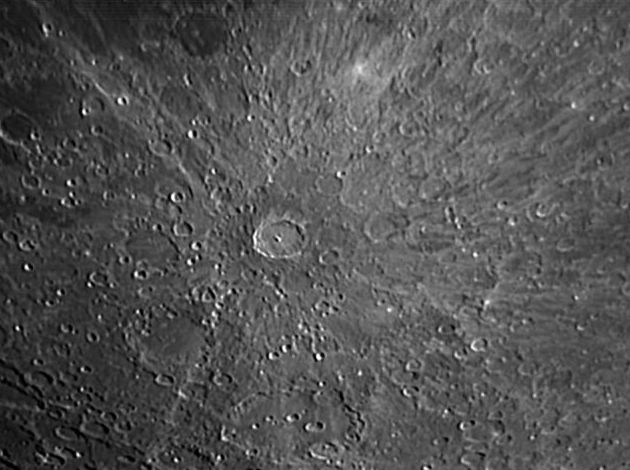
Here Tycho is seen, in its local environment, two days before Full Moon. Tycho is a very recent
impact crater and some of the features typical of an impact crater are visible in this and subsequent images.
Many of the rays are visible here,
with lots of them going to the east, and two prominent ones, one going towards the top, left-hand corner of
the picture, the other going through Longomontanus. It is this pattern of the rays that indicates that
the impacting body came in low from the west. Also visible is the dark halo around the crater,
extending out to Sasserides.
The picture was taken at 22:33 UT with a focal reducer giving a focal length of 800 mm.
K3CCDTools: 343 frames.
Registax: 147 frames stacked,
wavelets 1-3=10, histogram 0-230.
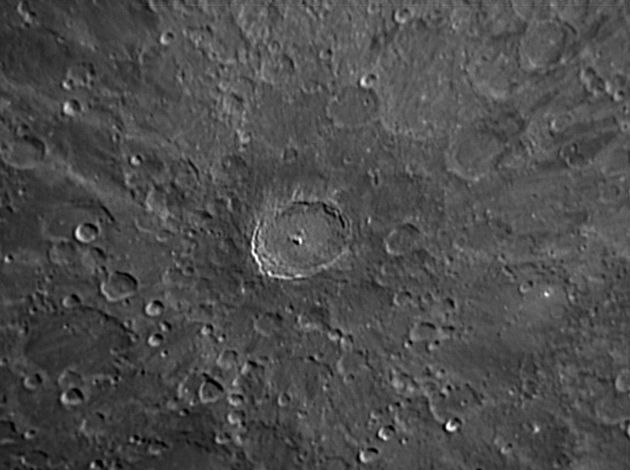
This is now a bit closer in. The dark halo is still visible, but the rays are no longer obvious,
although some streaking to the east can be seen. Detail within the crater is a little more apparent,
but can be seen in even more detail in the picture below.
The picture was taken at 20:54 UT at prime focus which is a focal length of 2500 mm.
K3CCDTools: 311 frames.
Registax: 100 frames stacked,
Wavelets 1-3=10, Histogram 0-160,
Contrast 70.
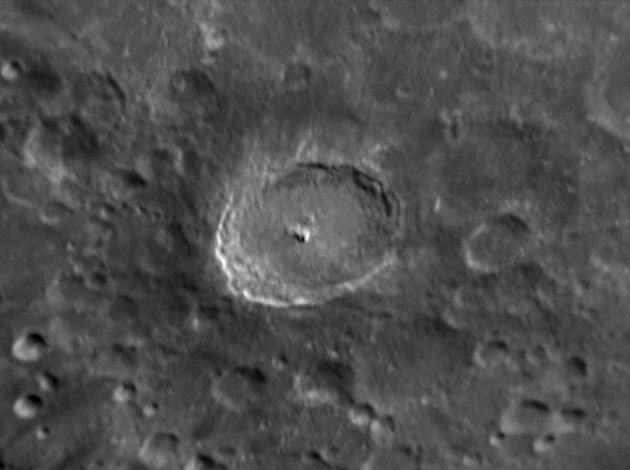
And here it is in close-up. Visible now are the terraced walls and the central mountain, both
typical of impact craters. The landing of Surveyor 7
here has been very important to lunar science because it contained instruments to measure the composition
of the rocks on which it landed. These proved to be significantly different from the mare material,
sampled by other Surveyor craft and by the Apollo astronauts. The samples returned to Earth by the
astronauts contained tiny fragments of rock of the same composition found by Surveyor 7.
The picture was taken at 22:06 UT with my X2 lens giving a focal length of 5000 mm.
K3CCDTools: 430 frames, low Gamma,
1/100" at 13% gain.
Registax: 100 frames stacked,
Wavelets 1-3=10, Histogram 0-160,
Contrast 70.
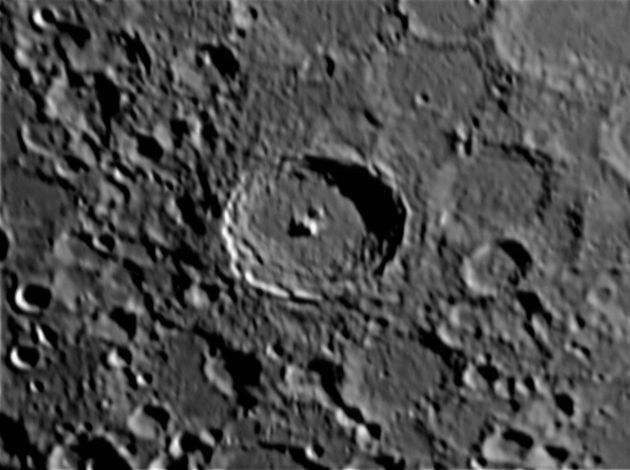
This picture of Tycho was taken three days before the pictures above, when the Moon was 9.5 days old, and is
on the same scale. The Sun is not quite so high and the extra shadows bring out a lot more detail. In
particular you can now see the terraces on the inner walls of Tycho.
There are so many craters in this area that identifying and labelling them has been difficult. The odd
ways in which the letters have been associated with the bigger craters has made me put in too many dotted lines.
The scale marks in the top right-hand corner indicate approximately 50 Km north and west.
The picture was taken using my LX200 with a X2 adaptor lens on 18th April 2005 at 20:41 UT when the Moon was 9.5 days old.
Date and Time: 18th April 2005 20:41 UT
Camera: ToUcam 740K
Telescope: LX200 with X2 adaptor lens
Capture: K3CCDTools. High gamma, 1/250", 10% gain, 358 frames
Processing: Registax. 151 frames stacked. Wavelets 1-6 = 10, Contrast 90
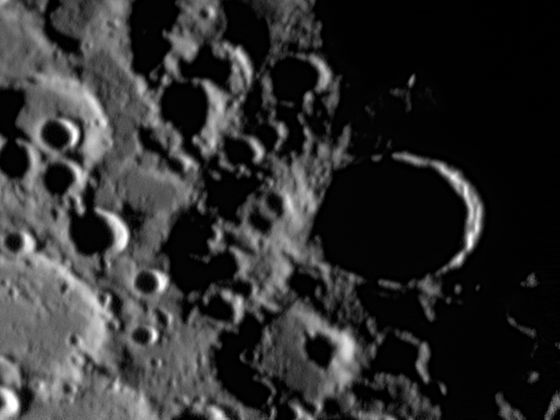
Here Tycho is seen at sunset so that all its interior is in darkness, only the eastern rim is still catching the Sun.
This low angle emphasises even more the ruggedness of this part of the surface.
The scale marks in the top right-hand corner indicate approximately 50 Km north and east.
The picture was taken using my LX200 with a X2 adaptor lens on 7th October 2004 at 03:39 UT when the Moon was 22.8 days old.
Date and Time: 7th October 2004 03:39 UT
Camera: ToUcam 740K
Telescope: LX200 with X2 adaptor lens
Capture K3CCDTools. High gamma, 1/50", 26% gain, 320 frames
Processing: Registax. 137 frames stacked. Wavelet 1-3 = 10
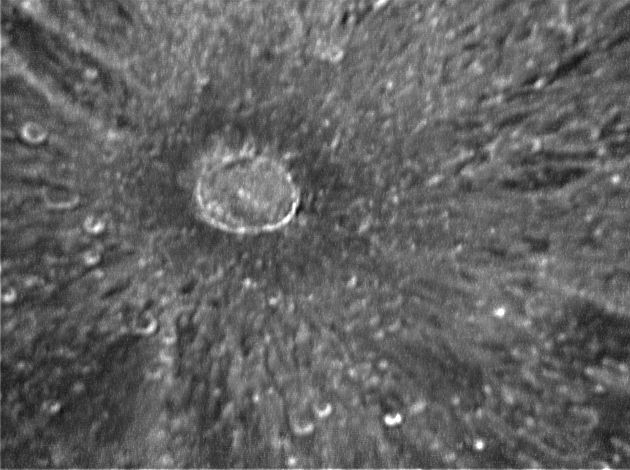 >
>
This is Tycho on Day 15.5 which is only a few hours after full Moon. The picture was taken in colour and enhanced fairly aggresively with wavelets in order to bring out the otherwise relatively flat picture, and finally rendered in monochrome. Move your mouse over the picture to see the exaggerated colour version.
The asymmetry of the blanket of ejecta can be seen most clearly as the brown areas in the colour picture. This is evidence that the impacting missile arrived at a fairly shallow angle from the west, a conclusion supported by the directions of the rays which can best be seen on pictures of the whole Moon.
The picture was taken using my LX200 on 16th November 2005 at 21:15 UT when the Moon was 15.5 days old.
Date and Time: 16th November 2005 21:15 UT
Camera: ToUcam 740K
Telescope: LX200 with Nd filter and the colours balanced in the camera
Capture K3CCDTools. Low gamma, high saturation 1/250", 0% gain, 461 frames
Processing: Registax. 124 frames stacked. Wavelet 1-3 = 10, histogram 50-190
PhotoImpact. Unsharp masking, Gaussian blur, and colour saturation to 30%
Home Back to SW Quadrant